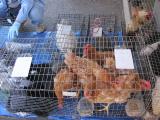A study designed to sift out some of the risk factors for H7N9 influenza in China found that exposure to live poultry and their environments were the main drivers, as well as having some types of chronic illness, researchers reported yesterday.
The group, from the Chinese Center for Disease Control and Prevention and provincial centers, focused their study on H7N9 patients from Jiangsu province, and they surveyed controls to identify features that did and didn't associate with infection risk. They published their findings in Eurosurveillance.
Jiangsu province had 27 cases as of May 27, but researchers excluded 2 of them, because one involved human-to-human transmission and data were missing for the other. Eight of the cases were fatal. The study included 93 controls that were matched by age, sex, and location.
Researchers conducted the survey between Apr 25 and May 12. It included questions about health status, daily habits, and activity and environmental exposures within 2 weeks of case illness onsets. Questions about poultry exposure asked about direct contact at markets, home, or work.
Patient ages ranged from 21 to 85, with 12 of them older than 60. Nineteen of the patients were men.
The three risk factors that stood out were direct contact with poultry or birds, environmental exposure, and chronic conditions except for hypertension.
The investigators said the direct contact risk factor is consistent with other findings and probably reflects the dynamics in poultry markets. Such venues support interspecies transmission and environments that could easily be contaminated by poultry feces and secretions, as well as organs exposed during slaughtering activities.
Chronic disease as a risk factor hasn't been seen with H5N1 infections, the group wrote, noting that age increases the risk of chronic diseases, possibly due to decreased immune function.
Researchers cautioned that the number of cases was small, so the study's power is limited in showing significant associations. They also noted that, for some patients, family members responded to the interview questions, which could result in a less definitive picture of exposure and possible bias.
The authors concluded that ongoing efforts are needed to educate the public about exposure risks. They added that additional poultry market measures, such as having centralized slaughtering sites, could help prevent the spread of the virus.
Ai J, Huang Y, Xu K, et al. Case-control study of risk factors for human infection with influenza A (H7N9) virus in Jiangsu province, China, 2013. Eurosurveill 2012 Jul 27;18(26):pii=20510 [Full text]




















